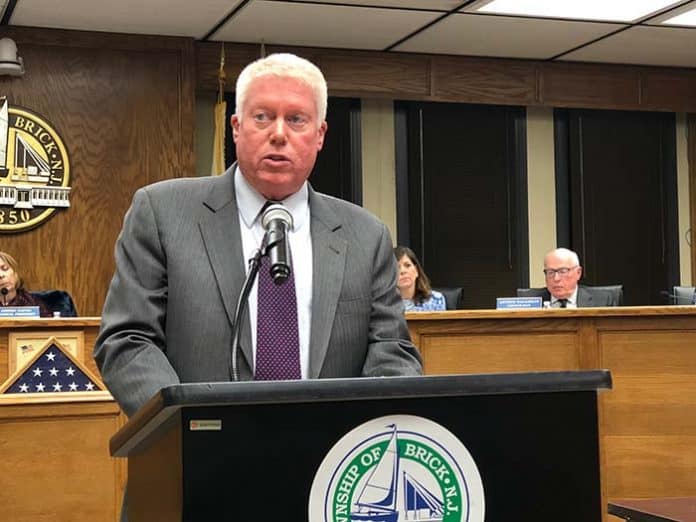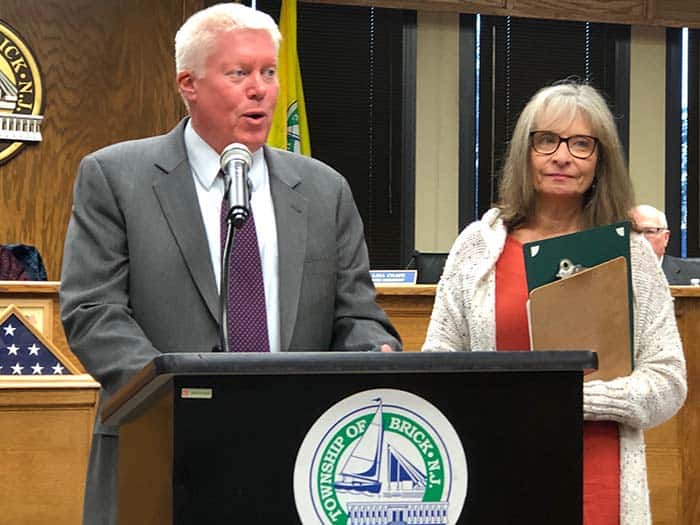
BRICK – Harbingers of spring include longer days, buds on trees, pothole repair and the introduction of the 2019 municipal budget, which Mayor John G. Ducey presented during the March 26 council meeting.
The $103,832,368 municipal budget is up $1,166,818 over last year’s budget, an increase of .9 percent – less than a penny on the tax rate. A person living in the average assessed home of $294,100 would pay 51 cents a week or $26.52 a year, he said.
The budget utilizes $8,573,806 of surplus as a revenue. The surplus fund must have a balance of $9.7 million, for a “healthy surplus balance that shows the fiscal health of a community,” Ducey said.
“It is not a savings account and shouldn’t be dipped into to offset the amount to be raised by taxes,” he said. “It’s part of the budget that requires replenishment every single year.”
Fiscally sound municipalities apply no more than half of their surplus towards their budget because the more the surplus amount is depleted the more money would need to be raised in the following year’s budget, Ducey said.
“I’d like to stand before you and say there have been no spending increases this year, however the reality of operating a town this size is – absent cuts in services or public safety – exceedingly difficult, if not impossible, to not have spending increases,” Ducey said.
The mayor said his administration has made every effort to fill positions in-house to keep new hires at a minimum. Employees were promoted at the Public Works Department, Purchasing, Planning, Zoning, Information Technology and Tax Assessor’s Departments.
Some of the cost increases include the cost of gasoline, pension contributions, and in salary and wage budgets for dispatch, emergency medical services and police, all 24/7 operations which sometimes require overtime resulting in unanticipated increases.

When Ducey took office six years ago, the township debt was $168 million, an increase of $86 million over a ten-year period. He said one of his priorities as mayor was to reduce the debt, which has been lowered by $22.9 million.
Councilman Jim Fozman asked if some of the surplus money – that was originally a loan earmarked for Superstorm Sandy recovery – could be used towards the budget so there would be no tax increase.
Specifically, Fozman was referring to part of a $5 million federal loan for disaster relief that the township had been saving in the event the loan had to be repaid. The loan was forgiven.
“I understand that money was supposed to be used to pay down debt. Could we use a portion of that to offset the .9 percent so taxpayers wouldn’t be charged anything this year? Is that possible?” he asked. “We’re gonna get hit by the school.”
Fozman was referring to a cut in state aid to the township school district that will result in a mandated 2 percent tax increase.
Ducey said the township CFO Maureen Lafferty-Berg recommends using the funds to pay down township debt.
“I’d rather see out debt go down so we don’t have to pay as much,” Ducey said. “You’re going to pay it anyway on the other end.”
Department heads have been presenting their budgets at the beginning of each council meeting. Director of Recreation Dan Santaniello and Police Chief James Riccio presented their budgets at the March 26 council meeting.
The budget presentations started during the March 12 council meeting, when Business Administrator Joanne Bergin, Department of Public Works Director Ken Mathis and Parks Department Director Rob Byrnes presented their spending plans.
Department heads from Engineering, Construction/Code Enforcement and Planning/Zoning will be presenting their budgets during the next council meeting on April 9 at 7 p.m.
A public hearing on the proposed 2019 municipal budget will be during the April 30 council meeting, after which the budget is expected to be adopted.






